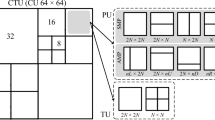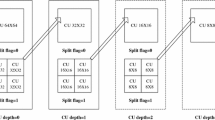Abstract
High-efficiency video coding (HEVC) utilizes a quadtree-structured coding unit (CU) for more possible sizes of basic blocks for later prediction. The exhaustive search for the optimal CU depth requires high complexity, which causes difficulties for real-time streaming. In the proposed method, we make use of the residual statistics of prediction units (PUs) in the current encoded CU to make a decision on CU early termination. The residual histogram is discussed, and the optimal early termination (ET) zone is designed; if the PU residual statistics fall in the ET zone, the early termination is triggered. The optimal parameters for the ET zone are solved and analyzed in the training stage, and can be estimated with table lookup and simple computations in the testing stage. Another early termination method using the neighboring SKIP information is also proposed. We use SKIP information from more meaningful CU neighbors defined and used in HEVC. We combine the proposed residual-based and SKIP-based algorithms with a state-of-the-art method. The experimental results show that compared to two state-of-the-art methods in both low delay (LP) and random access (RA) configurations, our preferred proposed combination can achieve the best BDBR results (0.737 % in LP and 0.471 % in RA) with a good corresponding TS performances (49.87 % in LP and 54.96 % in RA), making HEVC more suitable for real-time applications.










Similar content being viewed by others
Change history
27 July 2016
An erratum has been published.
References
Sullivan, G.J., Ohm, J., Han, W.-J., Wiegand, T.: Overview of the high efficiency video coding (HEVC) standard. IEEE Trans. Circuits Syst. Video Technol. 22, 1649–1668 (2012)
Wiegand, T., Ohm, J.R., Sullivan, G.J., Han, W.-J., Joshi, R., Tan, T.K., Ugur, K.: Special section on the joint call for proposals on high efficiency video coding (HEVC) standardization. IEEE Trans. Circuits Syst. Video Technol. 20, 1661–1666 (2010)
Bross, B., Han, W.-J., Ohm, J.-R., Sullivan, G.J., Wiegand, T.: JCTVC-J1003: High efficiency video coding (HEVC) text specification draft 8 (2012)
Kim, I.K., Min, J., Lee, T., Han, W.-J., Park, J.: Block partitioning structure in the HEVC standard. IEEE Trans. Circuits Syst. Video Technol. 22, 1697–1706 (2012)
Zhang, Y., Wang, H., Li, Z.: Fast coding unit depth decision algorithm for interframe coding in HEVC. In: Data Compression Conference (DCC) (2013)
Correa, G., Assuncao, P., Agostini, L., Cruz, L.A.: Coding tree depth estimation for complexity reduction of HEVC. In: Data Compression Conference (DCC) (2013)
Choi, K., Jang, E.S.: JCTVC-F092: coding tree pruning based CU early termination (2011)
Tan, H.L., Liu, F., Tan, Y.H., Yeo, C.: On fast coding tree block and mode decision for high-efficiency video coding (HEVC). In IEEE International Conference on Acoustics, Speech and Signal Processing (ICASSP) (2012)
Kim, J., Choe, Y., Kim, Y.-G.: Fast coding unit size decision algorithm for intra coding in HEVC. In: IEEE International Conference on Consumer Electronics (ICCE), pp. 637–638 (2013)
Yoo, H.-M., Suh, J.-W.: Fast coding unit decision algorithm based on inter and intra prediction unit termination for HEVC. In: IEEE International Conference on Consumer Electronics (ICCE), pp. 300–301 (2013)
Xiong, J., Li, H., Wu, Q., Meng, F.: A fast HEVC inter CU selection method based on pyramid motion divergence. IEEE Trans. Multimed. 16, 559–564 (2014)
Qiu, J., Liang, F., Luo, Y.: A fast coding unit selection algorithm for HEVC. In: IEEE International Conference on Multimedia and Expo Workshops (ICMEW) (2013)
Ahn, S., Kim, M., Park, S.: Fast decision of CU partitioning based on SAO parameter, motion and PU/TU split information for HEVC. In: IEEE Picture Coding Symposium (PCS) (2013)
Shen, L., Liu, Z., Zhang, X., Zhao, W., Zhang, Z.: An effective CU size decision method for HEVC encoders. IEEE Trans. Multimed. 15, 465–470 (2013)
Shen, L., Zhang, Z., Liu, Z.: Adaptive inter mode decision for HEVC jointly utilizing inter level and spatiotemporal correlations. IEEE Trans. Circuits Syst. Video Technol. 24, 1709–1722 (2014)
Shen, L.Q., Zhang, Z.Y., Liu, Z.: Effective CU size decision for HEVC intracoding. IEEE Trans. Image Process. 23, 4232–4241 (2014)
Min, B., Cheung, R.C.C.: A fast CU size decision algorithm for the HEVC intra encoder. IEEE Trans. Circuits Syst. Video Technol. 25, 892–896 (2015)
Goswami, K., Kim, B.-G., Jun, D., Jung, S.-H., Choi, J.S.: Early coding unit-splitting termination algorithm for high efficiency video coding (HEVC). ETRI J. 36, 407–417 (2014)
Goswami, K., Lee, J.-H., Jang, K.-S., Kim, B.-G., Kwon, K.-K.: Entropy difference-based early skip detection technique for high efficiency video coding. J. Real-Time Image Process.1–9 (2014). doi:10.1007/s11554-014-0476-0
Lee, J.-H., Goswami, K., Kim, B.-G., Jeong, S., Choi, J.S.: Fast encoding algorithm for high-efficiency video coding (HEVC) system based on spatio-temporal correlation. J. Real-Time Image Process. 1–12 (2015). doi:10.1007/s11554-014-0484-0
Ahn, Y.-J., Sim, D.: Square-type-first inter-CU tree search algorithm for acceleration of HEVC encoder. J. Real-Time Image Process. 1–14 (2015). doi:10.1007/s11554-015-0487-5
Lin, T.-L., Chen, W.-C., Lai, C.-K.: Recovery of lost motion vectors using encoded residual signals. IEEE Trans. Broadcast. 59, 705–716 (2013)
ITU.: Subjective video quality assessment methods for multimedia applications. ITU-T Recommendation P. 910 (1999)
Lin, T.-L., Chou, C.-C., Liao, C.-C., Tsai, W.-L., Chen, S.-L.: HEVC fast CU mode decision using spatial SKIP mode information. In: IEEE 3rd Global Conference on Consumer Electronics (GCCE) (2014)
Pourazad, M.T., Doutre, C., Azimi, M., Nasiopoulos, P.: HEVC: the new gold standard for video compression: how does HEVC compare with H.264/AVC? IEEE Consum. Electron. Mag. 1, 36–46 (2012)
Bossen, F., Common, H.: Test conditions and software reference configurations. JCTVC-L1100 (2013)
Pateux, S., Jung, J.: An Excel add-in for computing Bjontegaard metric and its evolution. In: ITU-T SG16/Q6, ed. Marrakech (2007)
Bjontegaard, G.: Calculation of average PSNR differences between RD-curves. In: ITU-T SG16/Q6, ed. Austin (2001)
Acknowledgments
This research is supported by the National Science Council, Taiwan, under Grants NSC 101-2221-E-033-036 and NSC 102-2221-E-033-018 and by the Ministry of Science and Technology, Taiwan, under Grant MOST 103-2221-E-033-020, MOST 104-2221-E-033-041 and MOST 104-2218-E-033-010.
Author information
Authors and Affiliations
Corresponding author
Rights and permissions
About this article
Cite this article
Lin, TL., Chou, CC., Liu, Z. et al. HEVC early termination methods for optimal CU decision utilizing encoding residual information. J Real-Time Image Proc 16, 1147–1163 (2019). https://doi.org/10.1007/s11554-016-0608-9
Received:
Accepted:
Published:
Issue Date:
DOI: https://doi.org/10.1007/s11554-016-0608-9




